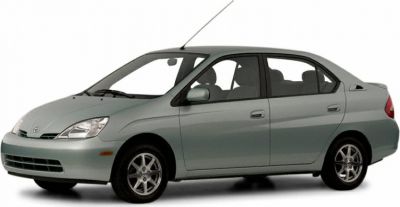 2000 Toyota Prius I (NHW11) Dimensions, Size & Specs
2000 Toyota Prius I (NHW11) Dimensions, Size & SpecsMeasurements of the 2000 Toyota Prius I, engineered for optimal performance and comfort
| Dimensions | |
|---|---|
| Length: | 4315 mm169.9 in14.2 ft |
| Width: | 1695 mm66.7 in5.6 ft |
| Width (Opened Mirrors): | 1945 mm76.6 in6.4 ft |
| Height: | 1475 mm58.1 in4.8 ft |
| Ground Clearance: | 124 mm4.9 in0.4 ft |
| Trunk Capacity: | 390 liter13.8 cu ft |
| Weight Specifications | |
| Curb Weight: | 1250 kg2756 lbs |
| Maximal permitted Weight: | 1645 kg3627 lbs |
| Roof Load: | 75 kg165 lbs |
| Tire Specifications | |
| Rims Size: | 14-inch rims:
|
| Tire Size: |
|
The Toyota Prius I (NHW11), produced between 2000 and 2003, marked the debut of Toyota's pioneering hybrid sedan that would revolutionize fuel efficiency. This first-generation Prius is a compact sedan with a length of 4315 mm (169.9 inches), width of 1695 mm (66.7 inches) excluding mirrors, and a width of 1945 mm (76.6 inches) with opened mirrors, offering a comfortable yet efficient footprint for urban and suburban driving. Standing at a height of 1475 mm (58.1 inches), the vehicle provides an aerodynamic silhouette contributing to its hybrid efficiency. The Prius I’s curb weight is 1250 kg (2,756 lbs), with a maximum weight capacity of 1645 kg (3,628 lbs), reflecting its lightweight build that enhances fuel economy and handling. The car rides with a ground clearance of 124 mm (4.9 inches), balancing maneuverability with sufficient clearance for everyday road conditions. Equipped with 5.5J x 14 rims and 175/65 R14 tires, the Prius I ensures a smooth and stable driving experience. Luggage capacity is 390 liters (13.8 cubic feet), which is generous for its class and suitable for daily errands or small trips. The roof load limit is 75 kg (165 lbs), allowing additional cargo options such as roof racks if needed. Overall, the Toyota Prius I (NHW11) stands as a compact, efficient sedan that set the benchmark for hybrid vehicles with its thoughtfully balanced dimensions and weight, catering to drivers seeking economy without compromising on space or practicality.
Discover the standout features that make the 2000 Toyota Prius I a leader in its class
Have a question? Please check our knowledgebase first.
The Toyota Prius I (NHW11), produced from 2000 to 2003, features a length of 4315 mm (169.7 inches), a width of 1695 mm (66.7 inches), and a height of 1475 mm (58.1 inches). When the side mirrors are opened, the width extends to 1945 mm (76.6 inches). These dimensions reflect the Prius I's compact yet practical sedan design, optimized for urban maneuverability while ensuring adequate interior space.
The Toyota Prius I (NHW11) has a curb weight of approximately 1250 kilograms (2756 pounds), which is the vehicle's weight without passengers or cargo but with standard equipment and fluids. The maximum allowable weight, including passengers, cargo, and the vehicle itself, is about 1645 kilograms (3626 pounds). This weight balance contributes to the vehicle's fuel efficiency and handling dynamics.
The Toyota Prius I (NHW11) offers a luggage capacity of 390 liters (13.8 cubic feet). This capacity provides a practical amount of storage space for a compact sedan, suitable for everyday commuting, shopping, and small trips. The cleverly designed rear hatch allows for flexible cargo loading, maximizing usability despite the car's compact size.
Yes, the Toyota Prius I (NHW11) generally fits comfortably into a standard residential garage. With its length of 4315 mm (about 4.3 meters or 169.7 inches), width of 1695 mm (66.7 inches), and height of 1475 mm (58.1 inches), it is smaller than most standard garage clearances, which typically accommodate vehicles up to around 6 meters (20 feet) in length and 2.5 meters (8.2 feet) in width, including mirrors. The opened mirror width of 1945 mm (76.6 inches) may require slight caution, but most garages are designed with enough space to accommodate this.
The Toyota Prius I (NHW11) has a ride height or ground clearance of 124 mm (4.9 inches). This relatively low ground clearance enhances aerodynamics, contributing to better fuel efficiency and stability on highways. However, it makes the Prius less ideal for rough or uneven terrain and more suited for urban and suburban road conditions.
The 2000-2003 Toyota Prius I (NHW11) comes equipped with 5.5J x 14 dimension rims, fitted with tires sized 175/65 R14. These tire and rim specifications are optimized to balance ride comfort, fuel efficiency, and road handling showing the car's hybrid design focus on efficiency. The 14-inch wheels contribute to a smooth ride and relatively low rolling resistance, compatible with urban and highway driving.
The Toyota Prius I (NHW11) was the first generation of the Prius model, so it has no predecessor for direct size comparison. Introduced in 2000, it set the benchmark for future Prius generations with its compact dimensions, lightweight design, and hatchback layout. Subsequent generations built upon this foundation, enlarging the vehicle slightly for more interior space, enhanced comfort, and improved hybrid technology.
When compared to similar early 2000s hybrid vehicles, such as the Honda Insight (first generation), the Toyota Prius I (NHW11) is slightly larger in both length and width. The Prius's length is 4315 mm (169.7 inches), while the Insight was shorter at approximately 4155 mm (163.6 inches). The Prius offers more interior and cargo space, exemplified by its 390-liter luggage capacity, compared to smaller competitors. The Prius's size effectively balanced urban maneuverability with passenger comfort, contributing to its market success.
The Toyota Prius I (NHW11) has a roof load capacity of 75 kg (165 lbs). This means it can safely accommodate roof racks, cargo boxes, or bicycle carriers within this weight limit. The roof's strength allows for additional cargo carrying options, which is particularly useful for outdoor activities or travel, enhancing the vehicle’s versatility without compromising safety or fuel efficiency.
The Toyota Prius I (NHW11) was designed with aerodynamic efficiency and compact sizing in mind. Its length of 4315 mm (169.7 inches), moderate width of 1695 mm (66.7 inches), and low height of 1475 mm (58.1 inches) contribute to a reduced frontal area and minimal air resistance. Additionally, the low ride height of 124 mm (4.9 inches) helps lower drag. These design choices, combined with the lightweight curb weight of 1250 kg (2756 lbs), facilitate better fuel economy by enhancing hybrid system efficiency and reducing energy loss through drag and weight.
Discover similar sized cars.

| Production: | 1997-2001 |
|---|---|
| Model Year: | 1997 |
| Length: | 4275 mm168.3 in |
| Width: | 1695 mm66.7 in |
| Height: | 1490 mm58.7 in |

| Production: | 2003-2009 |
|---|---|
| Model Year: | 2003 |
| Length: | 4310 mm169.7 in |
| Width: | 1695 mm66.7 in |
| Height: | 1485 mm58.5 in |

| Production: | 2004-2007 |
|---|---|
| Model Year: | 2004 |
| Length: | 4232 mm166.6 in |
| Width: | 1893 mm74.5 in |
| Height: | 1449 mm57.0 in |

| Production: | 2015-2017 |
|---|---|
| Model Year: | 2015 |
| Length: | 4320 mm170.1 in |
| Width: | 1722 mm67.8 in |
| Height: | 1489 mm58.6 in |

| Production: | 2015-2020 |
|---|---|
| Model Year: | 2015 |
| Length: | 4315 mm169.9 in |
| Width: | 1709 mm67.3 in |
| Height: | 1506 mm59.3 in |
